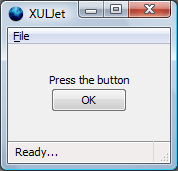XULJet
| Stable release |
XULJet-3.0.3
/ September 5, 2011 |
|---|---|
| Development status | Active |
| Written in | JavaScript |
| Operating system | Cross-platform |
| Type | JavaScript library |
| License | MIT License |
| Website | https://code.google.com/p/xuljet/ |
XULJet is an open-source JavaScript framework for the Mozilla XULRunner run-time environment. It is intended for writing desktop applications in pure JavaScript.
XULJet provides a component architecture and user interface elements description inspired by Seaside. It implements some CommonJS specifications.[1]
Examples
Hello world in XULJet:

var xuljet = require('lib/xuljet');
var Main = function(aWindow)
{
xuljet.Component.call(this, aWindow);
this.message = "Hello World!";
}
xuljet.inherits(Main, xuljet.Component);
Main.prototype.render = function(xul)
{
xul.vbox({flex: 1},
xul.toolbox(
xul.menubar(
xul.menu({label: "File", accesskey: "f"},
xul.menupopup(
xul.menuitem({label: "Close", oncommand: "window.close()"}))))),
xul.vbox({align: "center", pack: "center", flex: 1},
xul.description({bind: "desc"}, "Press the button"),
xul.button({label: "OK", oncommand: function() {
this["desc"].value = this.message}})),
xul.statusbar(
xul.statusbarpanel({flex: 1, label: 'Ready...'})))
}
}
function main()
{
var rootComponent = new Main(window);
window.setTitle("XULJet");
rootComponent.beMainWindowComponent();
}
See also
References
External links
- Official website
- XULJet mailing list - general discussion about XULJet
This article is issued from Wikipedia - version of the 9/11/2016. The text is available under the Creative Commons Attribution/Share Alike but additional terms may apply for the media files.